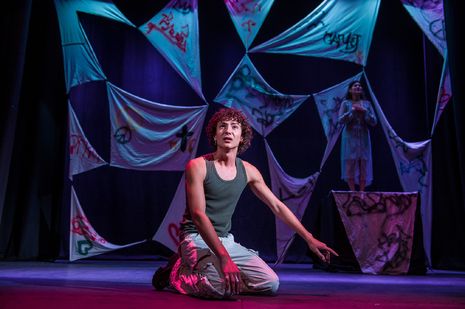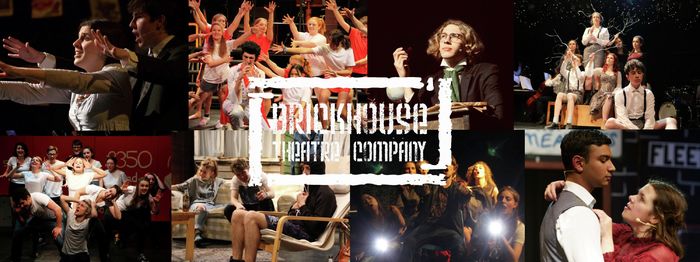Romeo and Juliet: too like the lightning
Supriya Finch finds CAST’s Romeo and Juliet to be an epitome of youthful energy, despite fizzling out on the ADC stage.

Anyone hoping to stage Shakespeare – especially a story as well-beloved as Romeo and Juliet – has to fight before it’s even begun not to collapse under the enormous weight of the play’s own personal canon. It has a kind of inherent cliché which can instantly render a production stale, with the thousands of actors who have spoken the same words before looming over the heads of those on stage.
“Jules Coyle’s Mercutio moves nimbly through Shakespeare’s wry riddling”
In this respect, the cast of CAST’s (Cambridge American Stage Tour) Romeo and Juliet hold up well. The performance is fresh and flowy, with its actors maintaining an easy fluency in their deliveries that is found in the best Shakespeare, encouraging the audience to fall into step with the characters as they amble along, joking and pontificating. The young Montagues, in particular, shine in the first half with their easy camaraderie and infectious bantering. Jules Coyle’s Mercutio moves nimbly through Shakespeare’s wry riddling, bringing a fantastic energy to every scene they’re in.
Unfortunately, despite the energetic attempts to the contrary, the show struggles to fill the stage a lot of the time. It’s hard to even pinpoint why this is the case – it just feels as though the actors’ voices get swallowed up by the space, and many scenes have a feeling of stasis. Particularly in the second half of the evening, moments of emotional climax struggled to land. Perhaps not helped by the use of plain lighting washes for most of the play and the formless synthy music tracks that appeared here and there, actors seemed to be standing around in a gaping maw that sometimes rendered their characters’ despair hard to relate to, leaving them almost absurd as they staggered about and deplored their fates into what felt like a vacuum.
“The somewhat poorly executed use of the typically working class art of graffiti to signal ‘dystopia’ and ‘violence’ is already uncomfortable”
To be fair, the show is a touring one, and therefore the blocking probably wasn’t tailored to the ADC, along with its lighting and set design. The set is minimalistic, with graffitied triangles of cloth neatly defining the space. It’s effective and funky, but (as ever) raised some questions for me. Unfortunately, the somewhat poorly executed use of the typically working class art of graffiti to signal ‘dystopia’ and ‘violence’ is already uncomfortable. Equally, seeing as the show clearly aimed to project notionally working class aesthetics and experiences onto its characters - using graffiti, switchblade knife fights and costumes compromised of singlets, cargo trousers and black boots – it jarred significantly to see the production fall into the age-old trap of having the illiterate, comic relief servant character be played by someone playing up their Northern accent significantly more than when they played a noble. I’d been discussing the ubiquity of this particular phenomenon right before leaving for the theatre, and didn’t exactly find it surprising to see yet another Cambridge production pulling out the trick of signalling characters’ comic, ancillary or antagonistic status via foreign or traditionally working class accents after encountering it in play after play last term.
“It’s still sturdy Shakespeare”
Beyond that botched attempt at humour, the show has a good go at balancing the comic and tragic aspects of the play, which is no mean feat since they often appear within seconds of each other. Though the energy becomes more subdued as the night wears on rather than ratcheting up as the tragedy gains momentum and becomes more inevitable, the tragic finale stays fresh. Though I won’t spoil it, I will say that it is all the more poignant for its innovative approach to the double death scene, which deftly side-steps the hackneyed traditional choreography of the scene and brings a new heartbreaking twist on the play’s well-worn conclusion.
Overall, the production is fun and assured – it just finds itself spread a little thin on the ADC mainstage where it may well have glowed in the Round Church or the American venues it found itself in. It’s still sturdy Shakespeare: funny, (mostly) self-aware and easy to engage with due to the actors solid grasp and conveyance of the source material. More than anything, it’s very young, and this plays both in and against its favour, lending it boldness and modernity but also a certain naive, ungrounded energy that can cause it to feel a little unanchored and overwrought in places. But what else is Romeo and Juliet about other than the young and audacious doing their level best to channel their energy and passion? In this sense, the show has it spot on.
Romeo and Juliet runs at the ADC from Tuesday 3rd - Saturday 2nd October.
 Features / Should I stay or should I go? Cambridge students and alumni reflect on how their memories stay with them15 December 2025
Features / Should I stay or should I go? Cambridge students and alumni reflect on how their memories stay with them15 December 2025 News / Cambridge study finds students learn better with notes than AI13 December 2025
News / Cambridge study finds students learn better with notes than AI13 December 2025 News / Uni Scout and Guide Club affirms trans inclusion 12 December 2025
News / Uni Scout and Guide Club affirms trans inclusion 12 December 2025 Comment / The magic of an eight-week term15 December 2025
Comment / The magic of an eight-week term15 December 2025 News / News In Brief: Michaelmas marriages, monogamous mammals, and messaging manipulation15 December 2025
News / News In Brief: Michaelmas marriages, monogamous mammals, and messaging manipulation15 December 2025








